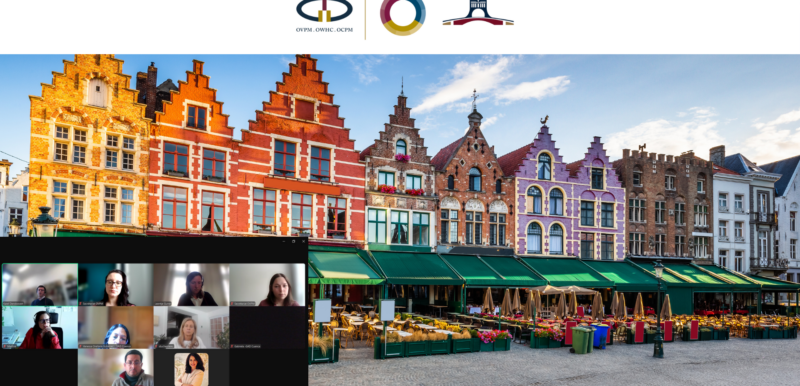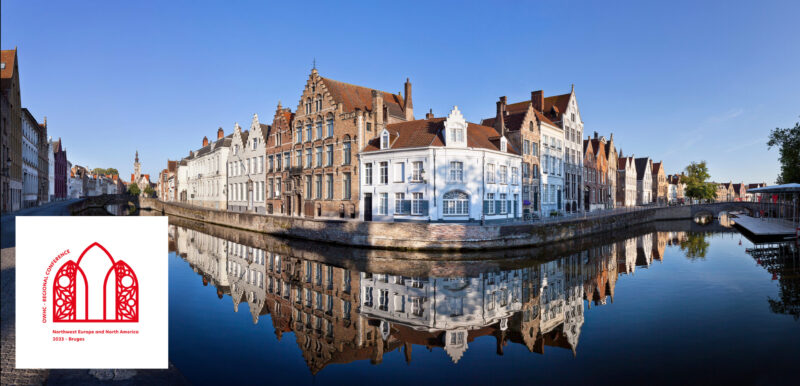Brugge, Belgium
General Information
Administrative status
County seat of the province of West-Flanders
Historic Centre of Brugge
Registration Year
2000
Historical function
Commercial, cultural and artistic
Location and site
Brugge is an outstanding example of a medieval historic settlement, which has maintained its historic fabric as this has evolved over the centuries, and where original Gothic constructions form part of the town’s identity. As one of the commercial and cultural capitals of Europe, Brugge developed cultural links to different parts of the world. It is closely associated with the school of Flemish Primitive painting.
Urban Morphology
The city reflects a considerable exchange of influences on the development of art and architecture, particularly in brick Gothic, which is characteristic of northern Europe and the Baltic. This architecture strongly determines the character of the historic centre of the city.
The 12th century city walls marked the boundaries of the medieval city. Although the walls themselves are lost today, they remain clearly visible, emphasized by the four surviving gates, the ramparts and one of the defence water towers. The medieval street pattern, with main roads leading towards the important public squares, has mostly been preserved, as well as the network of canals which, once used for mercantile traffic, played an important role in the development of the city.
Registration Criteria
Criterion (ii): The Historic Centre of Brugge bears testimony to a considerable exchange of influences on the development of architecture, and particularly brick Gothic architecture, over a long period of time. As the birthplace of the school of the Flemish Primitives, it has favoured innovative artistic influences in the development of medieval painting.
Criterion (iv): The Historic Centre of Brugge is an outstanding example of an architectural ensemble. The city’s public, social and religious institutions illustrate significant stages in the history of commerce and culture in medieval Europe
Criterion (vi): The Historic Centre of Brugge was birthplace of the Flemish Primitives and a centre of patronage and development of painting in the Middle Ages with artists such as Jan van Eyck and Hans Memling.
Historical Reference
- In the 15th century, Brugge was the cradle of the Flemish Primitives and a centre of patronage and painting development for artists such as Jan van Eyck and Hans Memling. Many of their works were exported and influenced painting styles all over Europe. Exceptionally important collections have remained in the city until today.
- Even after its economic and artistic peak at the end of the Middle Ages, building and urban development continued, although Brugge mostly missed the 19th-century industrial revolution. In the 18th and 19th centuries, many medieval parcels were joined to larger entities and new quarters were also developed. The most striking examples of large scale post-medieval interventions in the historic centre are the urbanization around Coupure (1751-1755), the Zand and the first railway station (1838), the Theatre quarter (1867), the Koningin Elisabethlaan and Gulden Vlieslaan (1897) and the creation of the Guido Gezelle-neighbourhood (1920-1930).
- In the second half of the 20th century, some major changes occurred with Zilverpand (1976), the new Public Library (1975-1978), the new Palace of Justice and Kartuizerswijk (1980), Clarendam (1990) and Colettijnenhof (1997).
Belfries of Belgium and France
Registration Year
1999
Historical function
Symbol of power and prosperity of the communes
Location and site
Twenty-three belfries in the north of France and the belfry of Gembloux in Belgium were inscribed in 2005, as an extension to the 32 Belgian belfries inscribed in 1999 as Belfries of Flanders and Wallonia. Built between the 11th and 17th centuries, they showcase the Roman, Gothic, Renaissance and Baroque styles of architecture. They are highly significant tokens of the winning of civil liberties. While Italian, German and English towns mainly opted to build town halls, in part of north-western Europe, greater emphasis was placed on building belfries. Compared with the keep (symbol of the seigneurs) and the bell-tower (symbol of the Church), the belfry, the third tower in the urban landscape, symbolizes the power of the aldermen. Over the centuries, they came to represent the influence and wealth of the towns.
Urban Morphology
High towers built in the heart of urban areas, often dominating the principal square, the belfries are essential elements in the organization and representation of the towns to which they belong. The site inscribed on the World Heritage List comprises 33 belfries located in Belgium (26 in Flanders and 7 in Wallonia) and 23 belfries located in northern France.
A symbolic element in the landscape in ancient Netherlands and the north of France, the belfry represents, in the heart of urban areas, the birth of municipal power in the Middle Ages. A practical building housing the communal bells, conserving charters and treasures, where city council meetings were held, serving as a watch tower and a prison, the belfry has, over the centuries, become the symbol of power and prosperity of the communes.
Registration Criteria
Criterion (ii): The belfries of Belgium and France are exceptional examples of a form of urban architecture adapted to the political and spiritual requirements of their age.
Criterion (iv): The Middle Ages saw the emergence of towns that were independent of the prevalent feudal system. The belfries of Belgium and France symbolize this new-found independence, and also the links within them between the secular and religious powers.
Historical Reference
- The belfries are, together with the market hall, significant representatives of civil and public architecture in Europe. The evolution from the “seigneurial keep” to the “communal keep” is noteworthy. The church belfries bear witness to the relationship, within the community, between civil and religious power. Closely associated with the expansion and government of European towns in the Middle Ages, the belfries, by the variety of their type and the evolution of their appearance, and the complexes with which they were often associated, represent an essential element in public architecture from the 11th century onwards.
- Beyond their architectural structure, the belfries present a wide typology linked both to the history of the communities, the period of construction, the materials used and the personality of their master builders. In the urban configuration, they can be isolated, attached to a market place or to a town hall. In several cases, the civil function is exercised by the church belfry. The period of construction of the belfries extends from the 11th to the 20th century, presenting a wide diversity of style, from Roman art to Art Deco.
- Bearing a strong identity, the belfries have suffered much damage from armed conflict but their regular rebuilding, occurring to this day, expresses their exceptional symbolic role and the communities’ attachment to them.
Flemish Béguinages
Registration Year
1998
Historical function
Exceptional testimony to the cultural tradition of independent religious women in northwestern Europe in the Middle Ages
Location and site
The Béguines were women who dedicated their lives to God without retiring from the world. In the 13th century they founded the béguinages , enclosed communities designed to meet their spiritual and material needs. The Flemish béguinages are architectural ensembles composed of houses, churches, ancillary buildings and green spaces, with a layout of either urban or rural origin and built in styles specific to the Flemish cultural region. They are a fascinating reminder of the tradition of the Béguines that developed in north-western Europe in the Middle Ages.
Urban Morphology
The Flemish béguinages are a series of 13 sites in the Flanders Region of Belgium. They bear extraordinary witness to the cultural tradition of the Beguines that developed in north-western Europe in the Middle Ages.
These Beguines were either unmarried or widowed women who entered into a life dedicated to God, but without retiring from the world. In the 13th century they founded the béguinages, enclosed communities designed to meet their spiritual and material needs.
The Flemish béguinages formed architectural ensembles, enclosed by walls or surrounded by ditches, with gates opening to the outside world during the day. Inside, they were composed of houses, churches, ancillary buildings, and green spaces organized in a spatial conception of urban or rural origin, and built in styles specific to the Flemish cultural region.
Registration Criteria
Criterion (ii): The Flemish béguinages demonstrate outstanding physical characteristics of urban and rural planning and a combination of religious and traditional architecture in styles specific to the Flemish cultural region.
Criterion (iii): The béguinages bear exceptional witness to the cultural tradition of independent religious women in north-western Europe in the Middle Ages.
Criterion (iv): The béguinages constitute an outstanding example of an architectural ensemble associated with a religious movement characteristic of the Middle Ages, associating both secular and conventual values.
Historical Reference
- The Flemish Béguinages, including the one in Bruges, represent an exceptional example of a distinct urban and religious tradition that flourished in Northwestern Europe from the 13th century. Designed as self-contained communities, they offered women—mostly lay and often unmarried—a space for spiritual life outside of traditional monastic orders, reflecting a unique social and religious innovation of the Middle Ages.
- The Bruges Béguinage (Begijnhof), founded in 1245, illustrates the integration of religious architecture with urban residential planning. Enclosed by walls and featuring a central church, small houses, and communal buildings, it is emblematic of the modest yet harmonious architecture that characterizes all Béguinages. Its layout is both functional and symbolic, evoking both seclusion and community.
- Beyond their architectural coherence, Béguinages are witnesses to the rise of female agency in medieval European society. They provided a semi-autonomous space within the cities, bridging civil and religious spheres without being fully subordinate to either. Their endurance and preservation underscore their historical importance and the strong cultural identity they embody.
Photos
News
6 July 2023
Regional Conference 2023 for Northwest Europe and North America in Bruges/Belgium
Brugge, Belgium
Northwest Europe and North America
Contact

M. Dirk De fauw
Bourgmestre
Ville de Bruges
Burg 12
Bruges, Belgique
B-8000
00.32 (0)50 44 81 13
[email protected]
Mme Minou Esquenet
Échevine pour le climat et l'énergie, la politique environnementale, Smart City et la gestion des installations
Ville de Bruges
Stadhuis, Burg 12, b-8000 brugge
Bruges, Belgique
050 47 54 38
[email protected]







